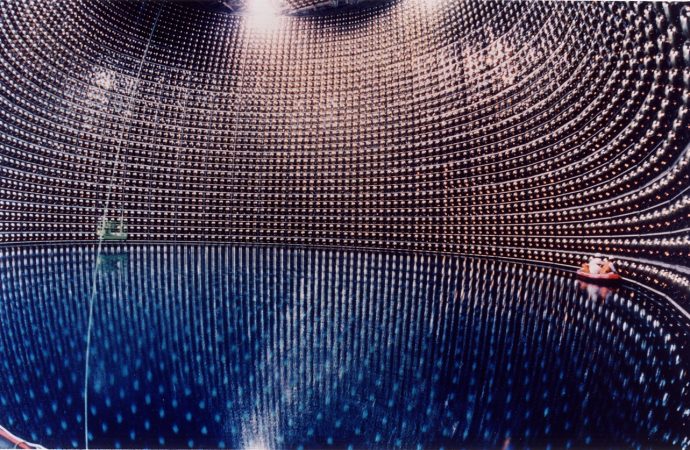Anomalous experimental results hint at the possibility of a fourth kind of neutrino, but more data only makes the situation more confusing. Katie Mack explains.
It was a balmy summer in 1998 when I first became aware of the confounding weirdness of neutrinos. I have vivid memories of that day, as an embarrassingly young student researcher, walking along a river in Japan, listening to a graduate student tell me about her own research project: an attempt to solve a frustrating neutrino–related mystery. We were both visiting a giant detector experiment called Super-Kamiokande, in the heady days right after it released data that forever altered the Standard Model of Particle Physics. What Super-K found was that neutrinos – ghostly, elusive particles that are produced in the hearts of stars and can pass through the whole Earth with only a miniscule chance of interacting with anything – have mass.
A particle having mass might not sound like a big deal, but the original version of the otherwise fantastically successful Standard Model described neutrinos as massless – just like photons, the particles that carry light and other electromagnetic waves. Unlike photons, however, neutrinos come in three ‘flavours’: electron, muon, and tau.
Super-K’s discovery was that neutrinos could change from one flavour to another as they travelled, in a process called oscillation. This can only happen if the three flavours have different masses from one another, which means they can’t be massless.
The finding suggested there must be a fourth neutrino, one invisible in experiments.
This discovery was a big deal, but it wasn’t the mystery the grad student was working to solve. A few years before, an experiment called the Liquid Scintillator Neutrino Detector (LSND), based in the US, had seen tantalising evidence that neutrinos were oscillating in a way that made no sense at all with the results of other experiments, including Super-K. The LSND finding indirectly suggested there had to be a fourth neutrino in the picture that the other neutrinos were sometimes oscillating into. This fourth neutrino would be invisible in experiments, lacking the kind of interactions that made the others detectable, which gave it the name ‘sterile neutrino’. And it would have to be much more massive than the other three.
As I learned that day by the river, the result had persisted, unexplained, for years. Most people assumed something had gone wrong with the experiment, but no one knew what.
In 2007, the plot thickened. An experiment called MiniBooNE, designed primarily to figure out what the heck happened with LSND, didn’t find the distribution of neutrinos it should have seen to confirm the LSND result. But some extra neutrinos did show up in MiniBooNE in a different energy range. They were inconsistent with LSND and every other experiment, perhaps suggesting the existence of even more flavours of neutrino.
Meanwhile, experiments looking at neutrinos produced by nuclear reactors were seeing numbers that also couldn’t easily be explained without a sterile neutrino, though some physicists wrote these off as possibly due to calibration errors.
And now the plot has grown even thicker.
In May, MiniBooNE announced new results that seem more consistent with LSND, but even less palatable in the context of other experiments. MiniBooNE works by creating a beam of muon neutrinos and shooting them through the dirt at an underground detector 450 m away. The detector, meanwhile, is monitoring the arrival of electron neutrinos, in case any muon neutrinos are shape-shifting. More of these electron neutrinos turn up than standard neutrino models predict, which implies that some muon neutrinos transform by oscillating into sterile neutrinos too. (Technically, all neutrinos would be swapping around with all others, but this beam only makes sense if there’s an extra, massive one in the mix.)
But there are several reasons this explanation is facing resistance. One is that experiments just looking for muon neutrinos disappearing (becoming sterile neutrinos or anything else) don’t find a consistent picture. Secondly, if sterile neutrinos at the proposed mass exist, they should have been around in the very early universe, and measurements we have from the cosmic microwave background of the number of neutrino types kicking around then strongly suggest it was just the normal three.
So, as usual, there’s more work to be done. A MiniBooNE follow-up called MicroBooNE is currently taking data and might make the picture clearer, and other experiments are on the way. It seems very likely that something strange is happening in the neutrino sector. It just remains to be seen exactly what, and how, over the next 20 years of constant neutrino bombardment, it will change our understanding of everything else.
Source: Cosmos Magazine

































Leave a Comment
You must be logged in to post a comment.